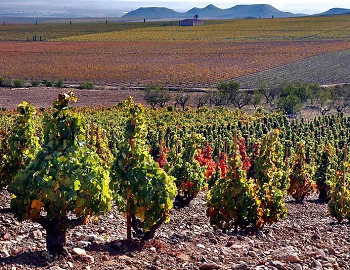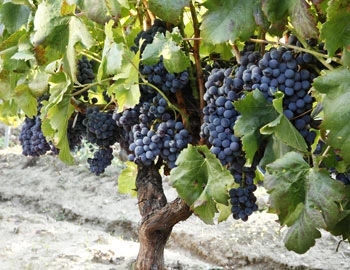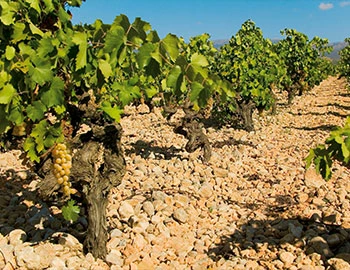
Propiedad Viñas Viejas 2017
DOC Rioja, Bodega Palacios Remondo, 750 ml

| Grape variety: | Garnacha |
| Producer: | Bodega Palacios Remondo |
| Origin: | Spain / Rioja |
| Other vintages: |
Description
This wine from Alvaro Palacios, made from 100% Garnacha vines some being very old, has a discreet impression. However, a single sip reveals its outstanding qualities with class and elegance. The taste is extremely long-lasting and complex. With the finest of tannins, it caresses the palate with lovely extracted sweetness. It is worth decanting the wine, so that it completely unfolds a wealth of flavours reminiscent of Provençal herbs and ripe summer fruit.
Attributes
| Origin: | Spain / Rioja |
| Grape variety: | Garnacha |
| Ripening potential: | 3 to 10 years |
| Drinking temperature: | 16 to 18 °C |
| Food Pairing: | Saddle of lamb fillet with herb jus, Wild specialities, Roast veal with morel sauce, Spicy hard cheese |
| Vinification: | fermentation in wooden barrel, Punching down, fermentation with grapes' own yeast |
| Harvest: | hand-picking, strict selection |
| Maturation: | in partly new and used barriques/ Pièces |
| Bottling: | filtration |
| Maturation duration: | 14 months |
| Volume: | 14.5 % |
| Note: | Contains sulphites |
Bodega Palacios Remondo
He was born 'at home', right above his father's bodega – Álvaro Palacios, Spains star vintner. The scent of wine and barrels must have been lying in the air and thus dictated his further life. He studied oenology in Bordeaux and gathered professional experience at the Château Pétrus, and in London, Dublin, and California. Today, he owns vines in the Priorat county, in Bierzo, and at home in the Rioja, and proves his extraordinary talent with premium wines year after year.
He loves his family, motorcycles, nature, songs by Camarón, a challenge and taking risks. He seems believable when he confesses that his second calling would have been to be a 'torero', a bullfighter. He bristles with dynamism and power.
He went to Bordeaux to study oenology when he was 21 years old. The next stage saw him working at the Château Pétrus for two years. Then he returned home. His father José Palacios Remondo had built a bodega in close to Alfaro in 1948 following a family tradition dating back to 1651. However, Álvaro felt constricted upon his return. In 1989, he was pulled towards the abandoned Priorat, where his first resounding success would take place shortly. He was restless to hurry to the next challenge in Bierzo, where he prompted the next furore. His international reputation as a star winegrower had already been established when his father died in 2000. This marked the right moment to return home – his birthplace.

Garnacha
Grenache seldom comes alone
Spaniards and Sardinians make the Grenache contentious: both claim it originated from their country. In fact, it had already appeared in both places by the 16th century. But a large number of mutations in Spain indicates that it has deeper roots on the Iberian Peninsula. The Grenache is meaty, rich in tannins and spicy, with a wonderful, fruity sweetness and rich aromas of blackberry, cassis, plums and pepper. Under the name Garnacha, it contributes fullness to the Rioja. In Sardinia it is called Cannonau, where it yields strong, expressive wines. But its stronghold is in France. Grenache is the star in Châteauneuf-du-Pape and streams into many other assemblages from the south. Its preferred partners are Syrah and Mourvèdre. This blend is also very popular abroad. In Australia, these wines are simply called "GSM".

Rioja
Rioja: A legend in upheaval
It is the flagship of the Spanish wine industry: the Rioja region, with its elegant, yet storable wines, most of which are dominated by the Tempranillo, has decisively influenced the image of Spanish wine. Above all, the Reservas and Gran Reservas, aged for years in barrels, enjoy a magical reputation. For about 20 years, the Rioja houses have created a sensation with modern-designed, fruity wines, which are marked more by their terroir than their aging processes.

Spain
Spain – Variety and perfection
“Somewhere in la Mancha, in a place whose name I do not care to remember...,” begins Don Quixote's odyssey.
The most famous part is definitely when Don Quixote thinks windmills are his enemy and wants to fight them – until they nearly kill him. It’s possible there was a bit too much of the La Mancha wine at play. Spanish vines fight for their survival in rugged landscapes, battling fierce drought and rough soils. But they fight well.


